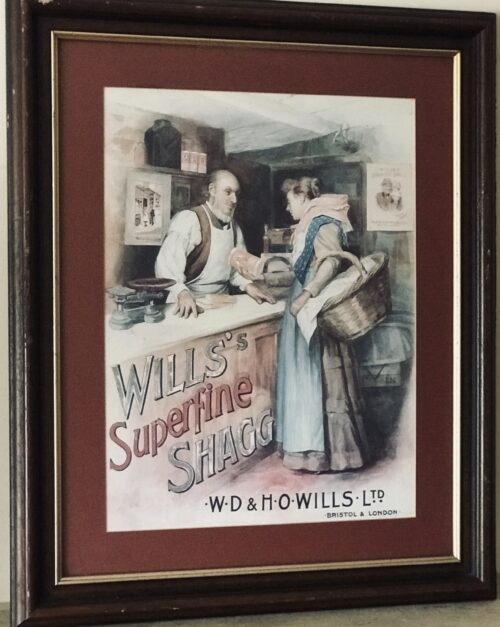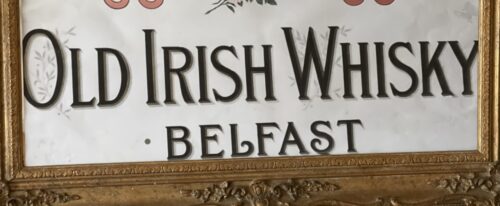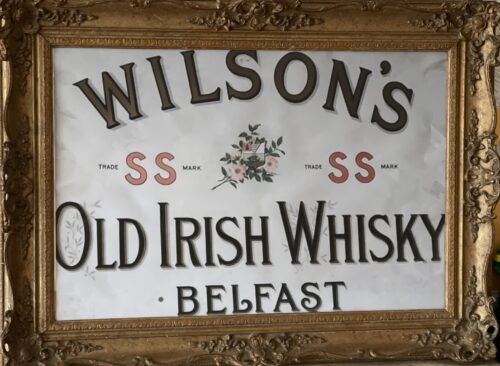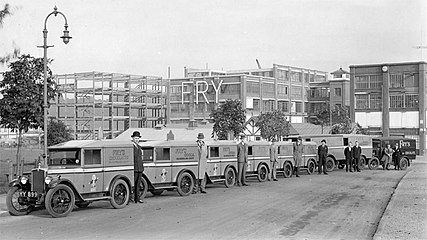-
 Cool retro ad from the 1970s with a bold and to the point message! Origins : Cork City Dimensions; 21cm x 32cm Glazed First produced in 1887, Wincarnis Tonic Wine is a natural tonic incorporating a unique infusion of herbs and spices. It’s also rich in vitamins, especially energy-giving Vitamin B complex. Usually enjoyed straight, Wincarnis Tonic Wine can also be mixed with gin to make a ‘Gin and Win’. Already a firm favourite in the United Kingdom, its export business continues to grow in Singapore, Malaysia, USA, West Indies and the UAE amongst many other markets.
Cool retro ad from the 1970s with a bold and to the point message! Origins : Cork City Dimensions; 21cm x 32cm Glazed First produced in 1887, Wincarnis Tonic Wine is a natural tonic incorporating a unique infusion of herbs and spices. It’s also rich in vitamins, especially energy-giving Vitamin B complex. Usually enjoyed straight, Wincarnis Tonic Wine can also be mixed with gin to make a ‘Gin and Win’. Already a firm favourite in the United Kingdom, its export business continues to grow in Singapore, Malaysia, USA, West Indies and the UAE amongst many other markets. -

 42cm x 32cm. Dublin Lovely collection of the once ubiquitous Wills Cigarettes collector cards depicting notable Irish Rugby players of the early part of the 20th Century such as G.V Stephenson,G.R Beamish and J.L Farrell. W.D. & H.O. Wills was a British tobacco importer and manufacturer formed in Bristol, England. It was the first UK company to mass-produce cigarettes. It was one of the founding companies of Imperial Tobacco along with John Player & Sons. The company was founded in 1786 and went by various names before 1830 when it became W.D. & H.O. Wills. Tobacco was processed and sold under several brand names, some of which were still used by Imperial Tobacco until the second half of the 20th century. The company pioneered the use of cigarette cards within their packaging. Many of the buildings in Bristol and other cities around the United Kingdom still exist with several being converted to residential use. Henry Overton Wills I arrived in Bristol in 1786 from Salisbury, and opened a tobacco shop on Castle Street with his partner Samuel Watkins. They named their firm Wills, Watkins & Co. When Watkins retired in 1789, the firm became Wills & Co. Next, the company was known from 1791 to 1793 as Lilly, Wills & Co, when it merged with the firm of Peter Lilly, who owned a snuff mill on the Land Yeo at Barrow Gurney. The company then was known from 1793 up until Lilly's' retirement in 1803 as Lilly and Wills. In 1826 H.O. Wills's sons William Day Wills and Henry Overton Wills II took over the company, which in 1830 became W.D. & H.O. Wills. William Day Wills' middle name is from his mother Anne Day of Bristol. Both W.D. and H.O. Wills were non-smokers. When William Day Wills was killed in 1865 in a carriage accident, 2000 people attended his funeral at Arnos Vale Cemetery.During the 1860s a new factory was built to replace the original Redcliffe Street premises, but they quickly outgrew this. The East Street factory of W.D. & H.O. Wills in Bedminster opened in 1886 with a high tea for the 900 employees in the Cigar Room. The new factory was expected to meet their needs for the remainder of the century, but within a decade it was doubled in size and early in the 1900s a further Bristol factory was created in Raleigh Road, Southville. This growth was largely due to the success of cigarettes. Their first brand was "Bristol", made at the London factory from 1871 to 1974. Three Castles and Gold Flake followed in 1878 but the greatest success was the machine-made Woodbine ten years later. Embassy was introduced in 1914 and relaunched in 1962 with coupons. Other popular brands included Capstan and Passing Clouds. The company also made cigar brands like Castella and Whiffs, several pipe tobacco brands and Golden Virginia hand-rolling tobacco. Up until 1920 only women and girls were employed as cigar-makers. One clause in the women's contract stipulated:
42cm x 32cm. Dublin Lovely collection of the once ubiquitous Wills Cigarettes collector cards depicting notable Irish Rugby players of the early part of the 20th Century such as G.V Stephenson,G.R Beamish and J.L Farrell. W.D. & H.O. Wills was a British tobacco importer and manufacturer formed in Bristol, England. It was the first UK company to mass-produce cigarettes. It was one of the founding companies of Imperial Tobacco along with John Player & Sons. The company was founded in 1786 and went by various names before 1830 when it became W.D. & H.O. Wills. Tobacco was processed and sold under several brand names, some of which were still used by Imperial Tobacco until the second half of the 20th century. The company pioneered the use of cigarette cards within their packaging. Many of the buildings in Bristol and other cities around the United Kingdom still exist with several being converted to residential use. Henry Overton Wills I arrived in Bristol in 1786 from Salisbury, and opened a tobacco shop on Castle Street with his partner Samuel Watkins. They named their firm Wills, Watkins & Co. When Watkins retired in 1789, the firm became Wills & Co. Next, the company was known from 1791 to 1793 as Lilly, Wills & Co, when it merged with the firm of Peter Lilly, who owned a snuff mill on the Land Yeo at Barrow Gurney. The company then was known from 1793 up until Lilly's' retirement in 1803 as Lilly and Wills. In 1826 H.O. Wills's sons William Day Wills and Henry Overton Wills II took over the company, which in 1830 became W.D. & H.O. Wills. William Day Wills' middle name is from his mother Anne Day of Bristol. Both W.D. and H.O. Wills were non-smokers. When William Day Wills was killed in 1865 in a carriage accident, 2000 people attended his funeral at Arnos Vale Cemetery.During the 1860s a new factory was built to replace the original Redcliffe Street premises, but they quickly outgrew this. The East Street factory of W.D. & H.O. Wills in Bedminster opened in 1886 with a high tea for the 900 employees in the Cigar Room. The new factory was expected to meet their needs for the remainder of the century, but within a decade it was doubled in size and early in the 1900s a further Bristol factory was created in Raleigh Road, Southville. This growth was largely due to the success of cigarettes. Their first brand was "Bristol", made at the London factory from 1871 to 1974. Three Castles and Gold Flake followed in 1878 but the greatest success was the machine-made Woodbine ten years later. Embassy was introduced in 1914 and relaunched in 1962 with coupons. Other popular brands included Capstan and Passing Clouds. The company also made cigar brands like Castella and Whiffs, several pipe tobacco brands and Golden Virginia hand-rolling tobacco. Up until 1920 only women and girls were employed as cigar-makers. One clause in the women's contract stipulated: The Wills Building in Newcastle upon Tyne, a former W.D. & H.O. Wills factoryIn 1898 Henry Herbert Wills visited Australia which led to the establishment of W.D. & H.O. Wills (Australia) Ltd. in 1900.When Princess Elizabeth visited on 3 March 1950 she was given cigarette cards as a gift for Prince Charles. In 1901 thirteen British tobacco companies discussed the American Tobacco Company building a factory in the UK to bypass taxes. The Imperial Tobacco Company was incorporated on 10 December 1901 with seven of the directors being members of the Wills family. Imperial remains one of the world's largest tobacco companies.
The Wills Building in Newcastle upon Tyne, a former W.D. & H.O. Wills factoryIn 1898 Henry Herbert Wills visited Australia which led to the establishment of W.D. & H.O. Wills (Australia) Ltd. in 1900.When Princess Elizabeth visited on 3 March 1950 she was given cigarette cards as a gift for Prince Charles. In 1901 thirteen British tobacco companies discussed the American Tobacco Company building a factory in the UK to bypass taxes. The Imperial Tobacco Company was incorporated on 10 December 1901 with seven of the directors being members of the Wills family. Imperial remains one of the world's largest tobacco companies. The former W.D. & H.O. warehouse building in Perth, Western AustraliaThe last member of the Wills family to serve the company was Christopher, the great great grandson of H.O. Wills I. He retired as sales research manager in 1969. The company had factories and offices not only in Bristol, but also in Swindon, Dublin, Newcastle and Glasgow. The largest cigarette factory in Europe was opened at Hartcliffe Bristol, and was designed by Skidmore, Owings & Merrill in 1974, but closed in 1990. It proved impossible to find a new use for it and it was demolished in 1999; its site is now the Imperial Park retail complex, but the associated offices became Lakeshore, residential apartments created by Urban Splash. The facade of the large factory in Bedminster and bonded warehouses at Cumberland Basin remain prominent buildings in Bristol, although much of the existing land and buildings have been converted to other uses, such as The Tobacco Factory Theatre. The Newcastle factory closed in 1986 and stood derelict for over a decade, before the front of the Art Deco building – which was preserved by being Grade II listed – reopened as a block of luxury apartments in 1998. (See main article: Wills Building) The factory in Glasgow has similarly been converted into offices. In 1988 Imperial Tobacco withdrew the Wills brand in the United Kingdom (except for the popular Woodbine and Capstan Full Strength brands, which still carry the name). The company pioneered canteens for the workers, free medical care, sports facilities and paid holidays. Wills commissioned portraits of long-serving employees, several of which are held by Bristol Museum and Art Gallery and some of which can be seen on display at the M Shed museum. In 1893 the W.D. & H.O. Wills Ltd Association Football Team was established and the company also held singing classes for the younger workers and women that year.In 1899 wives of Wills employees serving in the Boer War were granted 10 shillings per week by the factory. Bristol Archives holds extensive records of W.D. & H.O. Wills and Imperial Tobacco . In addition there are photographs of the Newcastle factory of W.D. & H.O. Wills at Tyne and Wear Archives in Bristol holds the Wills Collection of Tobacco Antiquities, consisting of advertising, marketing and packaging samples from the company's history, photographs and artefacts relating to the history of tobacco. In 1959 the company launched the short-lived Strand brand. This was accompanied by the iconic, but commercially disastrous, You're never alone with a Strand television advertisement. In India, the Gold Flake, Classic and Wills Navy Cut range of cigarettes, manufactured by ITC , formerly the Imperial Tobacco Company of India Limited,still has W.D. & H.O. Wills printed on the cigarettes and their packaging. These lines of cigarettes have a dominant market share. In 1887, Wills were one of the first UK tobacco companies to include advertising cards in their packs of cigarettes, but it was not until 1895 that they produced their first general interest set of cards ('Ships and Sailors'). Other Wills sets include 'Aviation' (1910), 'Lucky Charms' (1923), 'British Butterflies' (1927), 'Famous Golfers' (1930), 'Garden Flowers' (1933) and 'Air Raid Precautions' (1938) Wills also released several sports sets, such as the cricket (1901, 1908, 1909, 1910), association football (1902, 1935, 1939), rugby union (1902, 1929) and Australian rules football (1905) series.A Woodbine vending machine, now in the Staffordshire County Museumat Shugborough Hall, England
The former W.D. & H.O. warehouse building in Perth, Western AustraliaThe last member of the Wills family to serve the company was Christopher, the great great grandson of H.O. Wills I. He retired as sales research manager in 1969. The company had factories and offices not only in Bristol, but also in Swindon, Dublin, Newcastle and Glasgow. The largest cigarette factory in Europe was opened at Hartcliffe Bristol, and was designed by Skidmore, Owings & Merrill in 1974, but closed in 1990. It proved impossible to find a new use for it and it was demolished in 1999; its site is now the Imperial Park retail complex, but the associated offices became Lakeshore, residential apartments created by Urban Splash. The facade of the large factory in Bedminster and bonded warehouses at Cumberland Basin remain prominent buildings in Bristol, although much of the existing land and buildings have been converted to other uses, such as The Tobacco Factory Theatre. The Newcastle factory closed in 1986 and stood derelict for over a decade, before the front of the Art Deco building – which was preserved by being Grade II listed – reopened as a block of luxury apartments in 1998. (See main article: Wills Building) The factory in Glasgow has similarly been converted into offices. In 1988 Imperial Tobacco withdrew the Wills brand in the United Kingdom (except for the popular Woodbine and Capstan Full Strength brands, which still carry the name). The company pioneered canteens for the workers, free medical care, sports facilities and paid holidays. Wills commissioned portraits of long-serving employees, several of which are held by Bristol Museum and Art Gallery and some of which can be seen on display at the M Shed museum. In 1893 the W.D. & H.O. Wills Ltd Association Football Team was established and the company also held singing classes for the younger workers and women that year.In 1899 wives of Wills employees serving in the Boer War were granted 10 shillings per week by the factory. Bristol Archives holds extensive records of W.D. & H.O. Wills and Imperial Tobacco . In addition there are photographs of the Newcastle factory of W.D. & H.O. Wills at Tyne and Wear Archives in Bristol holds the Wills Collection of Tobacco Antiquities, consisting of advertising, marketing and packaging samples from the company's history, photographs and artefacts relating to the history of tobacco. In 1959 the company launched the short-lived Strand brand. This was accompanied by the iconic, but commercially disastrous, You're never alone with a Strand television advertisement. In India, the Gold Flake, Classic and Wills Navy Cut range of cigarettes, manufactured by ITC , formerly the Imperial Tobacco Company of India Limited,still has W.D. & H.O. Wills printed on the cigarettes and their packaging. These lines of cigarettes have a dominant market share. In 1887, Wills were one of the first UK tobacco companies to include advertising cards in their packs of cigarettes, but it was not until 1895 that they produced their first general interest set of cards ('Ships and Sailors'). Other Wills sets include 'Aviation' (1910), 'Lucky Charms' (1923), 'British Butterflies' (1927), 'Famous Golfers' (1930), 'Garden Flowers' (1933) and 'Air Raid Precautions' (1938) Wills also released several sports sets, such as the cricket (1901, 1908, 1909, 1910), association football (1902, 1935, 1939), rugby union (1902, 1929) and Australian rules football (1905) series.A Woodbine vending machine, now in the Staffordshire County Museumat Shugborough Hall, England-
Franklin Roosevelt, 1902
-
J.E. Doig of Sunderland, 1902
-
James Dickson of Port Adelaide, 1906
-
S.J. Cagney of Ireland, 1929
-
Stanley Matthews, 1939
-
New Croton Dam, NY The factory in Hartcliffe, Bristol, was the location for the filming of UK television series Doctor Who, Episode 95 - The Sun Makers (1977). Filming at the Wills Factory spanned 13 to 15 June 1977. In addition to the roof and tunnels, scenes were also filmed in the lift and the roof vent.
-
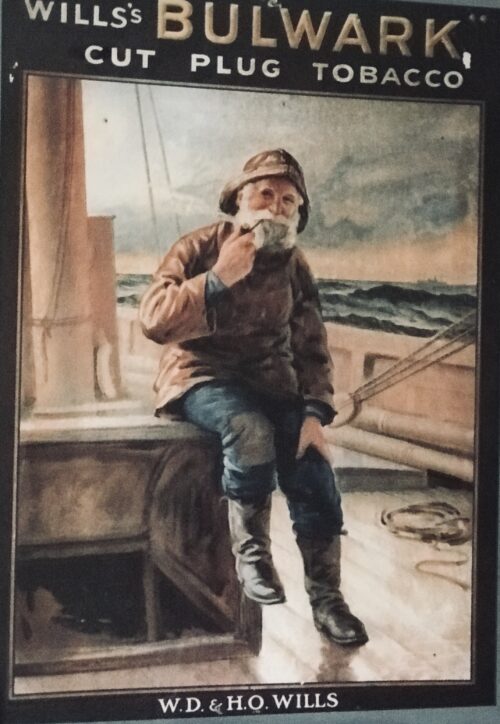
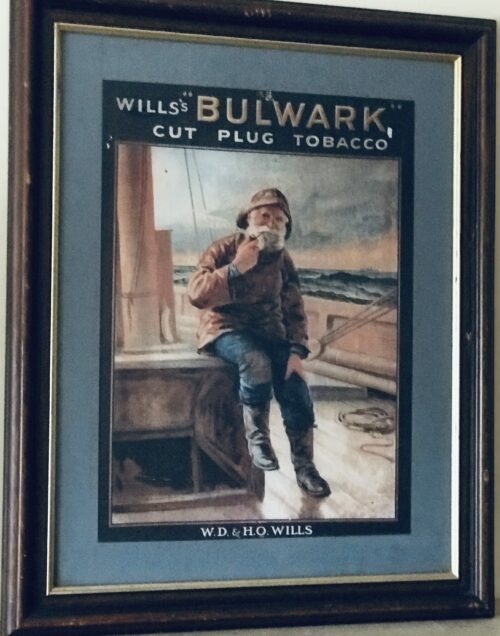 63cm x 52cm. Dublin W.D. & H.O. Wills was a British tobacco importer and manufacturer formed in Bristol, England. It was the first UK company to mass-produce cigarettes. It was one of the founding companies of Imperial Tobacco along with John Player & Sons. The company was founded in 1786 and went by various names before 1830 when it became W.D. & H.O. Wills. Tobacco was processed and sold under several brand names, some of which were still used by Imperial Tobacco until the second half of the 20th century. The company pioneered the use of cigarette cards within their packaging. Many of the buildings in Bristol and other cities around the United Kingdom still exist with several being converted to residential use. Henry Overton Wills I arrived in Bristol in 1786 from Salisbury, and opened a tobacco shop on Castle Street with his partner Samuel Watkins. They named their firm Wills, Watkins & Co. When Watkins retired in 1789, the firm became Wills & Co. Next, the company was known from 1791 to 1793 as Lilly, Wills & Co, when it merged with the firm of Peter Lilly, who owned a snuff mill on the Land Yeo at Barrow Gurney. The company then was known from 1793 up until Lilly's' retirement in 1803 as Lilly and Wills. In 1826 H.O. Wills's sons William Day Wills and Henry Overton Wills II took over the company, which in 1830 became W.D. & H.O. Wills. William Day Wills' middle name is from his mother Anne Day of Bristol. Both W.D. and H.O. Wills were non-smokers. When William Day Wills was killed in 1865 in a carriage accident, 2000 people attended his funeral at Arnos Vale Cemetery.During the 1860s a new factory was built to replace the original Redcliffe Street premises, but they quickly outgrew this. The East Street factory of W.D. & H.O. Wills in Bedminster opened in 1886 with a high tea for the 900 employees in the Cigar Room. The new factory was expected to meet their needs for the remainder of the century, but within a decade it was doubled in size and early in the 1900s a further Bristol factory was created in Raleigh Road, Southville. This growth was largely due to the success of cigarettes. Their first brand was "Bristol", made at the London factory from 1871 to 1974. Three Castles and Gold Flake followed in 1878 but the greatest success was the machine-made Woodbine ten years later. Embassy was introduced in 1914 and relaunched in 1962 with coupons. Other popular brands included Capstan and Passing Clouds. The company also made cigar brands like Castella and Whiffs, several pipe tobacco brands and Golden Virginia hand-rolling tobacco. Up until 1920 only women and girls were employed as cigar-makers. One clause in the women's contract stipulated:
63cm x 52cm. Dublin W.D. & H.O. Wills was a British tobacco importer and manufacturer formed in Bristol, England. It was the first UK company to mass-produce cigarettes. It was one of the founding companies of Imperial Tobacco along with John Player & Sons. The company was founded in 1786 and went by various names before 1830 when it became W.D. & H.O. Wills. Tobacco was processed and sold under several brand names, some of which were still used by Imperial Tobacco until the second half of the 20th century. The company pioneered the use of cigarette cards within their packaging. Many of the buildings in Bristol and other cities around the United Kingdom still exist with several being converted to residential use. Henry Overton Wills I arrived in Bristol in 1786 from Salisbury, and opened a tobacco shop on Castle Street with his partner Samuel Watkins. They named their firm Wills, Watkins & Co. When Watkins retired in 1789, the firm became Wills & Co. Next, the company was known from 1791 to 1793 as Lilly, Wills & Co, when it merged with the firm of Peter Lilly, who owned a snuff mill on the Land Yeo at Barrow Gurney. The company then was known from 1793 up until Lilly's' retirement in 1803 as Lilly and Wills. In 1826 H.O. Wills's sons William Day Wills and Henry Overton Wills II took over the company, which in 1830 became W.D. & H.O. Wills. William Day Wills' middle name is from his mother Anne Day of Bristol. Both W.D. and H.O. Wills were non-smokers. When William Day Wills was killed in 1865 in a carriage accident, 2000 people attended his funeral at Arnos Vale Cemetery.During the 1860s a new factory was built to replace the original Redcliffe Street premises, but they quickly outgrew this. The East Street factory of W.D. & H.O. Wills in Bedminster opened in 1886 with a high tea for the 900 employees in the Cigar Room. The new factory was expected to meet their needs for the remainder of the century, but within a decade it was doubled in size and early in the 1900s a further Bristol factory was created in Raleigh Road, Southville. This growth was largely due to the success of cigarettes. Their first brand was "Bristol", made at the London factory from 1871 to 1974. Three Castles and Gold Flake followed in 1878 but the greatest success was the machine-made Woodbine ten years later. Embassy was introduced in 1914 and relaunched in 1962 with coupons. Other popular brands included Capstan and Passing Clouds. The company also made cigar brands like Castella and Whiffs, several pipe tobacco brands and Golden Virginia hand-rolling tobacco. Up until 1920 only women and girls were employed as cigar-makers. One clause in the women's contract stipulated: The Wills Building in Newcastle upon Tyne, a former W.D. & H.O. Wills factoryIn 1898 Henry Herbert Wills visited Australia which led to the establishment of W.D. & H.O. Wills (Australia) Ltd. in 1900.When Princess Elizabeth visited on 3 March 1950 she was given cigarette cards as a gift for Prince Charles. In 1901 thirteen British tobacco companies discussed the American Tobacco Company building a factory in the UK to bypass taxes. The Imperial Tobacco Company was incorporated on 10 December 1901 with seven of the directors being members of the Wills family. Imperial remains one of the world's largest tobacco companies.
The Wills Building in Newcastle upon Tyne, a former W.D. & H.O. Wills factoryIn 1898 Henry Herbert Wills visited Australia which led to the establishment of W.D. & H.O. Wills (Australia) Ltd. in 1900.When Princess Elizabeth visited on 3 March 1950 she was given cigarette cards as a gift for Prince Charles. In 1901 thirteen British tobacco companies discussed the American Tobacco Company building a factory in the UK to bypass taxes. The Imperial Tobacco Company was incorporated on 10 December 1901 with seven of the directors being members of the Wills family. Imperial remains one of the world's largest tobacco companies. The former W.D. & H.O. warehouse building in Perth, Western AustraliaThe last member of the Wills family to serve the company was Christopher, the great great grandson of H.O. Wills I. He retired as sales research manager in 1969. The company had factories and offices not only in Bristol, but also in Swindon, Dublin, Newcastle and Glasgow. The largest cigarette factory in Europe was opened at Hartcliffe Bristol, and was designed by Skidmore, Owings & Merrill in 1974, but closed in 1990. It proved impossible to find a new use for it and it was demolished in 1999; its site is now the Imperial Park retail complex, but the associated offices became Lakeshore, residential apartments created by Urban Splash. The facade of the large factory in Bedminster and bonded warehouses at Cumberland Basin remain prominent buildings in Bristol, although much of the existing land and buildings have been converted to other uses, such as The Tobacco Factory Theatre. The Newcastle factory closed in 1986 and stood derelict for over a decade, before the front of the Art Deco building – which was preserved by being Grade II listed – reopened as a block of luxury apartments in 1998. (See main article: Wills Building) The factory in Glasgow has similarly been converted into offices. In 1988 Imperial Tobacco withdrew the Wills brand in the United Kingdom (except for the popular Woodbine and Capstan Full Strength brands, which still carry the name). The company pioneered canteens for the workers, free medical care, sports facilities and paid holidays. Wills commissioned portraits of long-serving employees, several of which are held by Bristol Museum and Art Gallery and some of which can be seen on display at the M Shed museum. In 1893 the W.D. & H.O. Wills Ltd Association Football Team was established and the company also held singing classes for the younger workers and women that year.In 1899 wives of Wills employees serving in the Boer War were granted 10 shillings per week by the factory. Bristol Archives holds extensive records of W.D. & H.O. Wills and Imperial Tobacco . In addition there are photographs of the Newcastle factory of W.D. & H.O. Wills at Tyne and Wear Archives in Bristol holds the Wills Collection of Tobacco Antiquities, consisting of advertising, marketing and packaging samples from the company's history, photographs and artefacts relating to the history of tobacco. In 1959 the company launched the short-lived Strand brand. This was accompanied by the iconic, but commercially disastrous, You're never alone with a Strand television advertisement. In India, the Gold Flake, Classic and Wills Navy Cut range of cigarettes, manufactured by ITC , formerly the Imperial Tobacco Company of India Limited,still has W.D. & H.O. Wills printed on the cigarettes and their packaging. These lines of cigarettes have a dominant market share. In 1887, Wills were one of the first UK tobacco companies to include advertising cards in their packs of cigarettes, but it was not until 1895 that they produced their first general interest set of cards ('Ships and Sailors'). Other Wills sets include 'Aviation' (1910), 'Lucky Charms' (1923), 'British Butterflies' (1927), 'Famous Golfers' (1930), 'Garden Flowers' (1933) and 'Air Raid Precautions' (1938) Wills also released several sports sets, such as the cricket (1901, 1908, 1909, 1910), association football (1902, 1935, 1939), rugby union (1902, 1929) and Australian rules football (1905) series.A Woodbine vending machine, now in the Staffordshire County Museumat Shugborough Hall, England
The former W.D. & H.O. warehouse building in Perth, Western AustraliaThe last member of the Wills family to serve the company was Christopher, the great great grandson of H.O. Wills I. He retired as sales research manager in 1969. The company had factories and offices not only in Bristol, but also in Swindon, Dublin, Newcastle and Glasgow. The largest cigarette factory in Europe was opened at Hartcliffe Bristol, and was designed by Skidmore, Owings & Merrill in 1974, but closed in 1990. It proved impossible to find a new use for it and it was demolished in 1999; its site is now the Imperial Park retail complex, but the associated offices became Lakeshore, residential apartments created by Urban Splash. The facade of the large factory in Bedminster and bonded warehouses at Cumberland Basin remain prominent buildings in Bristol, although much of the existing land and buildings have been converted to other uses, such as The Tobacco Factory Theatre. The Newcastle factory closed in 1986 and stood derelict for over a decade, before the front of the Art Deco building – which was preserved by being Grade II listed – reopened as a block of luxury apartments in 1998. (See main article: Wills Building) The factory in Glasgow has similarly been converted into offices. In 1988 Imperial Tobacco withdrew the Wills brand in the United Kingdom (except for the popular Woodbine and Capstan Full Strength brands, which still carry the name). The company pioneered canteens for the workers, free medical care, sports facilities and paid holidays. Wills commissioned portraits of long-serving employees, several of which are held by Bristol Museum and Art Gallery and some of which can be seen on display at the M Shed museum. In 1893 the W.D. & H.O. Wills Ltd Association Football Team was established and the company also held singing classes for the younger workers and women that year.In 1899 wives of Wills employees serving in the Boer War were granted 10 shillings per week by the factory. Bristol Archives holds extensive records of W.D. & H.O. Wills and Imperial Tobacco . In addition there are photographs of the Newcastle factory of W.D. & H.O. Wills at Tyne and Wear Archives in Bristol holds the Wills Collection of Tobacco Antiquities, consisting of advertising, marketing and packaging samples from the company's history, photographs and artefacts relating to the history of tobacco. In 1959 the company launched the short-lived Strand brand. This was accompanied by the iconic, but commercially disastrous, You're never alone with a Strand television advertisement. In India, the Gold Flake, Classic and Wills Navy Cut range of cigarettes, manufactured by ITC , formerly the Imperial Tobacco Company of India Limited,still has W.D. & H.O. Wills printed on the cigarettes and their packaging. These lines of cigarettes have a dominant market share. In 1887, Wills were one of the first UK tobacco companies to include advertising cards in their packs of cigarettes, but it was not until 1895 that they produced their first general interest set of cards ('Ships and Sailors'). Other Wills sets include 'Aviation' (1910), 'Lucky Charms' (1923), 'British Butterflies' (1927), 'Famous Golfers' (1930), 'Garden Flowers' (1933) and 'Air Raid Precautions' (1938) Wills also released several sports sets, such as the cricket (1901, 1908, 1909, 1910), association football (1902, 1935, 1939), rugby union (1902, 1929) and Australian rules football (1905) series.A Woodbine vending machine, now in the Staffordshire County Museumat Shugborough Hall, England-
Franklin Roosevelt, 1902
-
J.E. Doig of Sunderland, 1902
-
James Dickson of Port Adelaide, 1906
-
S.J. Cagney of Ireland, 1929
-
Stanley Matthews, 1939
-
New Croton Dam, NY The factory in Hartcliffe, Bristol, was the location for the filming of UK television series Doctor Who, Episode 95 - The Sun Makers (1977). Filming at the Wills Factory spanned 13 to 15 June 1977. In addition to the roof and tunnels, scenes were also filmed in the lift and the roof vent.
-

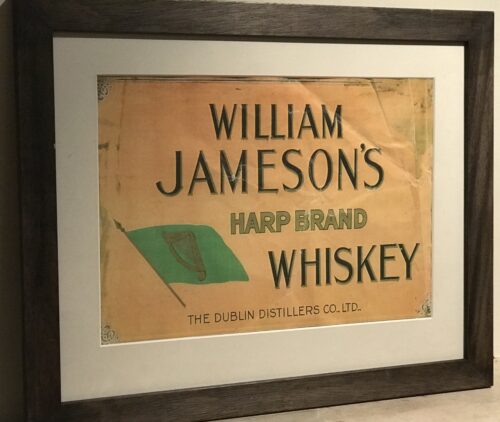 44cm x 55cm Dublin The Marrowbone Lane Distillery was an Irish whiskey distillery located on Marrowbone Lane, in Dublin, Ireland. One of the "big four" historical Dublin whiskey firms, it was run by William Jameson, a member of the Jameson whiskey dynasty. However, the whiskey now known as Jameson Irish Whiskey was not produced at this distillery, but at the separate enterprise run by John Jameson at the nearby Bow Street Distillery. The distillery closed in 1923 following financial difficulties.The precise origins of the distillery are uncertain, however, it was likely established in the 1750s (possibly 1752) and later acquired by the Stein family, relatives of the Jameson family circa 1780. An excise return in 1802 lists Stein and Jameson, however, by 1822 the company had become William Jameson & Co. Initially a small undertaking, with an output of just 30,000 gallons per annum, the distillery expanded over time, and by the time Alfred Barnard, a British historian visited the distillery in the 1880s, it had grown to cover some 14 acres. In his book, The Whisky Distilleries of the United Kingdom, Barnard described Marrowbone Lane as having some of the biggest distilling equipment in the world, including two mash tuns with capacities in excess of 100,000 gallons, which were the "said to be the largest in the United Kingdom". At its peak, the distillery was the second largest in Dublin (then one of the world's largest whiskey distilling centres), with an output of 900,000 gallons per annum, and a staff of 200, including 30 coopers. The whiskey produced at the distillery, known as "Dublin Whiskey" was chiefly exported to Australia, Canada, India and the United States. Later renamed the Dublin Distilling Company, the company entered financial difficulties in the late 1800s, and in 1891, merged with George Roe's Thomas Street Distillery and the Dublin Whiskey Distillery Company's Jones Road Distillery to form the Dublin Distilleries Company Ltd. Although, the amalgamated company had a potential production capacity of 3.5 million gallons per annum, it continued to endure severe financial difficulties, in particular, following the loss of both the American and British Commonwealth export markets during prohibition and the Anglo-Irish trade war in the 1920s. Both the Thomas Street and Marrowbone Lane distilleries closed in 1923, with the Jones Road Distillery following suit in 1926. Though distilling may have continued at Jones Road until 1946. During the 1916 Easter uprising, both the Marrowbone Lane distillery and Roe's distillery at Thomas Street were used as strongpoints by a force of more than a hundred rebels.
44cm x 55cm Dublin The Marrowbone Lane Distillery was an Irish whiskey distillery located on Marrowbone Lane, in Dublin, Ireland. One of the "big four" historical Dublin whiskey firms, it was run by William Jameson, a member of the Jameson whiskey dynasty. However, the whiskey now known as Jameson Irish Whiskey was not produced at this distillery, but at the separate enterprise run by John Jameson at the nearby Bow Street Distillery. The distillery closed in 1923 following financial difficulties.The precise origins of the distillery are uncertain, however, it was likely established in the 1750s (possibly 1752) and later acquired by the Stein family, relatives of the Jameson family circa 1780. An excise return in 1802 lists Stein and Jameson, however, by 1822 the company had become William Jameson & Co. Initially a small undertaking, with an output of just 30,000 gallons per annum, the distillery expanded over time, and by the time Alfred Barnard, a British historian visited the distillery in the 1880s, it had grown to cover some 14 acres. In his book, The Whisky Distilleries of the United Kingdom, Barnard described Marrowbone Lane as having some of the biggest distilling equipment in the world, including two mash tuns with capacities in excess of 100,000 gallons, which were the "said to be the largest in the United Kingdom". At its peak, the distillery was the second largest in Dublin (then one of the world's largest whiskey distilling centres), with an output of 900,000 gallons per annum, and a staff of 200, including 30 coopers. The whiskey produced at the distillery, known as "Dublin Whiskey" was chiefly exported to Australia, Canada, India and the United States. Later renamed the Dublin Distilling Company, the company entered financial difficulties in the late 1800s, and in 1891, merged with George Roe's Thomas Street Distillery and the Dublin Whiskey Distillery Company's Jones Road Distillery to form the Dublin Distilleries Company Ltd. Although, the amalgamated company had a potential production capacity of 3.5 million gallons per annum, it continued to endure severe financial difficulties, in particular, following the loss of both the American and British Commonwealth export markets during prohibition and the Anglo-Irish trade war in the 1920s. Both the Thomas Street and Marrowbone Lane distilleries closed in 1923, with the Jones Road Distillery following suit in 1926. Though distilling may have continued at Jones Road until 1946. During the 1916 Easter uprising, both the Marrowbone Lane distillery and Roe's distillery at Thomas Street were used as strongpoints by a force of more than a hundred rebels. -
 William Jameson Whisky Advert from the Cork Industrial Exhibition Programme in 1883. 30cm x 45cm Dublin William Jameson & Co (Marrowbone Lane Distillery) was an Irish whiskey distillery located on Marrowbone Lane, in Dublin, Ireland. One of the "big four" historical Dublin whiskey firms, it was run by William Jameson, a member of the Jameson whiskey dynasty. However, the whiskey now known as Jameson Irish Whiskey was not produced at this distillery, but at the separate enterprise run by John Jameson at the nearby Bow Street Distillery. The distillery closed in 1923 following financial difficulties.The precise origins of the distillery are uncertain, however, it was likely established in the 1750s (possibly 1752) and later acquired by the Stein family, relatives of the Jameson family circa 1780. An excise return in 1802 lists Stein and Jameson, however, by 1822 the company had become William Jameson & Co. Initially a small undertaking, with an output of just 30,000 gallons per annum, the distillery expanded over time, and by the time Alfred Barnard, a British historian visited the distillery in the 1880s, it had grown to cover some 14 acres.In his book, The Whisky Distilleries of the United Kingdom, Barnard described Marrowbone Lane as having some of the biggest distilling equipment in the world, including two mash tuns with capacities in excess of 100,000 gallons, which were the "said to be the largest in the United Kingdom". At its peak, the distillery was the second largest in Dublin (then one of the world's largest whiskey distilling centres), with an output of 900,000 gallons per annum, and a staff of 200, including 30 coopers. The whiskey produced at the distillery, known as "Dublin Whiskey" was chiefly exported to Australia, Canada, India and the United States. Later renamed the Dublin Distilling Company, the company entered financial difficulties in the late 1800s, and in 1891, merged with George Roe's Thomas Street Distillery and the Dublin Whiskey Distillery Company's Jones Road Distillery to form the Dublin Distilleries Company Ltd. Although, the amalgamated company had a potential production capacity of 3.5 million gallons per annum, it continued to endure severe financial difficulties, in particular, following the loss of both the American and British Commonwealth export markets during prohibition and the Anglo-Irish trade war in the 1920s. Both the Thomas Street and Marrowbone Lane distilleries closed in 1923, with the Jones Road Distillery following suit in 1926. Though distilling may have continued at Jones Road until 1946. During the 1916 Easter uprising, both the Marrowbone Lane distillery and Roe's distillery at Thomas Street were used as strongpoints by a force of more than a hundred rebels.
William Jameson Whisky Advert from the Cork Industrial Exhibition Programme in 1883. 30cm x 45cm Dublin William Jameson & Co (Marrowbone Lane Distillery) was an Irish whiskey distillery located on Marrowbone Lane, in Dublin, Ireland. One of the "big four" historical Dublin whiskey firms, it was run by William Jameson, a member of the Jameson whiskey dynasty. However, the whiskey now known as Jameson Irish Whiskey was not produced at this distillery, but at the separate enterprise run by John Jameson at the nearby Bow Street Distillery. The distillery closed in 1923 following financial difficulties.The precise origins of the distillery are uncertain, however, it was likely established in the 1750s (possibly 1752) and later acquired by the Stein family, relatives of the Jameson family circa 1780. An excise return in 1802 lists Stein and Jameson, however, by 1822 the company had become William Jameson & Co. Initially a small undertaking, with an output of just 30,000 gallons per annum, the distillery expanded over time, and by the time Alfred Barnard, a British historian visited the distillery in the 1880s, it had grown to cover some 14 acres.In his book, The Whisky Distilleries of the United Kingdom, Barnard described Marrowbone Lane as having some of the biggest distilling equipment in the world, including two mash tuns with capacities in excess of 100,000 gallons, which were the "said to be the largest in the United Kingdom". At its peak, the distillery was the second largest in Dublin (then one of the world's largest whiskey distilling centres), with an output of 900,000 gallons per annum, and a staff of 200, including 30 coopers. The whiskey produced at the distillery, known as "Dublin Whiskey" was chiefly exported to Australia, Canada, India and the United States. Later renamed the Dublin Distilling Company, the company entered financial difficulties in the late 1800s, and in 1891, merged with George Roe's Thomas Street Distillery and the Dublin Whiskey Distillery Company's Jones Road Distillery to form the Dublin Distilleries Company Ltd. Although, the amalgamated company had a potential production capacity of 3.5 million gallons per annum, it continued to endure severe financial difficulties, in particular, following the loss of both the American and British Commonwealth export markets during prohibition and the Anglo-Irish trade war in the 1920s. Both the Thomas Street and Marrowbone Lane distilleries closed in 1923, with the Jones Road Distillery following suit in 1926. Though distilling may have continued at Jones Road until 1946. During the 1916 Easter uprising, both the Marrowbone Lane distillery and Roe's distillery at Thomas Street were used as strongpoints by a force of more than a hundred rebels. -
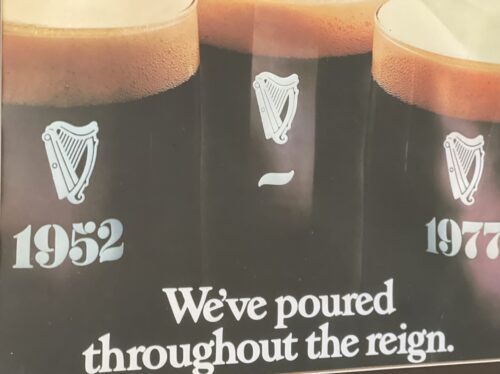
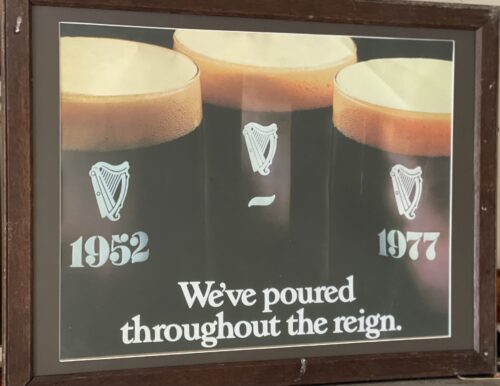 55cm x 70cm Imagination is something Guinness Advertising has never been short of… From John Gilroy’s hapless zookeeper and his menagerie of creatures to a Polynesian surfer and a herd of white horses; from messages in bottles setting sail across the ocean to a single, heart-stoppingly enormous wave. Guinness have been carving out their own creative path for almost a century with decades of extraordinary and enduring print, TV and digital campaigns to their name, and hopefully they will continue to push boundaries to tell stories to the world. Here’s to original thinking !
55cm x 70cm Imagination is something Guinness Advertising has never been short of… From John Gilroy’s hapless zookeeper and his menagerie of creatures to a Polynesian surfer and a herd of white horses; from messages in bottles setting sail across the ocean to a single, heart-stoppingly enormous wave. Guinness have been carving out their own creative path for almost a century with decades of extraordinary and enduring print, TV and digital campaigns to their name, and hopefully they will continue to push boundaries to tell stories to the world. Here’s to original thinking ! -

 Fantastic vintage W.& R.Jacob & Co.Ltd Biscuit & Cake Manufacturers Dublin Advert depicting the famous Dublin Landmark which played such a pivotal role in the 1916 Easter Rising which altered the course of Irish History forever. Clonsilla Dublin 45.5cm x 57.5cm The biscuit making firm of W. & R. Jacob's were one the largest employers in the Dublin of 1916, and their factory was seized on Easter Monday by perhaps 100 members of the 2nd Battalion of the Dublin Brigade of the Irish Volunteers under Thomas MacDonagh. The factory itself was an enormous and formidable Victorian edifice located on the 'block' enclosed by Bishop St, Bride St, Peter's St and Peter's Row, and between St Patrick's Cathedral and St Stephen's Green. Its seizure helped to complete a loop of building cross the south inner city; the factory had two large towers that could act as observation points, while its location was very close to both Camden St and Patrick St: natural routeways for troops entering the city centre from Portobello Barracks in Rathmines and Wellington Barracks on the South Circular Road. There were only a few staff present in the building when the Volunteers broke into it; a number of smaller outposts were established in the area around the factory. While the garrison saw some fighting early in the week, their principal enemies proved to be boredom and the locals: the factory was surrounded by tenements, and the Volunteers were attacked and abused by residents, many of whom were Jacob's workers themselves. The families of servicemen were also quite hostile, but there may have been another reason for this hostility: Michael O'Hanrahan, who was in Jacob's, expressed his concern that the choice of location might endanger local residents if the British chose to attack. As it happens, the factory was largely by-passed, though it was fired upon intermittently throughout the week by troops in Dublin Castle and elsewhere. MacDonagh surrendered in nearby St Patrick's Park on Sunday 30 April; some of the factory was looted after the Volunteers had left. Three members of the Jacob's garrison were executed. Most of the factory was eventually demolished, though fragments of the ground storey and one of the towers are still visible on Bishop St between the DIT campus on Aungier St and the National Archives of Ireland.
Fantastic vintage W.& R.Jacob & Co.Ltd Biscuit & Cake Manufacturers Dublin Advert depicting the famous Dublin Landmark which played such a pivotal role in the 1916 Easter Rising which altered the course of Irish History forever. Clonsilla Dublin 45.5cm x 57.5cm The biscuit making firm of W. & R. Jacob's were one the largest employers in the Dublin of 1916, and their factory was seized on Easter Monday by perhaps 100 members of the 2nd Battalion of the Dublin Brigade of the Irish Volunteers under Thomas MacDonagh. The factory itself was an enormous and formidable Victorian edifice located on the 'block' enclosed by Bishop St, Bride St, Peter's St and Peter's Row, and between St Patrick's Cathedral and St Stephen's Green. Its seizure helped to complete a loop of building cross the south inner city; the factory had two large towers that could act as observation points, while its location was very close to both Camden St and Patrick St: natural routeways for troops entering the city centre from Portobello Barracks in Rathmines and Wellington Barracks on the South Circular Road. There were only a few staff present in the building when the Volunteers broke into it; a number of smaller outposts were established in the area around the factory. While the garrison saw some fighting early in the week, their principal enemies proved to be boredom and the locals: the factory was surrounded by tenements, and the Volunteers were attacked and abused by residents, many of whom were Jacob's workers themselves. The families of servicemen were also quite hostile, but there may have been another reason for this hostility: Michael O'Hanrahan, who was in Jacob's, expressed his concern that the choice of location might endanger local residents if the British chose to attack. As it happens, the factory was largely by-passed, though it was fired upon intermittently throughout the week by troops in Dublin Castle and elsewhere. MacDonagh surrendered in nearby St Patrick's Park on Sunday 30 April; some of the factory was looted after the Volunteers had left. Three members of the Jacob's garrison were executed. Most of the factory was eventually demolished, though fragments of the ground storey and one of the towers are still visible on Bishop St between the DIT campus on Aungier St and the National Archives of Ireland. -

 50cm x 70cm Drumcondra Dublin Once the Willy Wonka chocolate factory of Dublin,Williams & Woods kept generations of children and adults happy with their large range of confectionary items as advertised in this rare, original print from the late 1890s.The company is long gone but happily the building has been put to good use as you can read below.William's & Woods building on King's Inn Street in Dublin City Centre is where it all began - the first home to the Chocolate Factory shared creative space. Once manufacturing various sweet treats including Toblerone and Mint Crisp, this industrial building now houses an eclectic mix of small businesses and individuals in creative sectors including art, design, music, photography, craft, up-cycling, dance, illustration, graphics, events, horticulture, baking and small batch food & drink production. The incredible transformation and re-invention of Dublin's first concrete building into a creative and collaborative space continues in addition to other alternative Chocolate Factory venues around the country.
50cm x 70cm Drumcondra Dublin Once the Willy Wonka chocolate factory of Dublin,Williams & Woods kept generations of children and adults happy with their large range of confectionary items as advertised in this rare, original print from the late 1890s.The company is long gone but happily the building has been put to good use as you can read below.William's & Woods building on King's Inn Street in Dublin City Centre is where it all began - the first home to the Chocolate Factory shared creative space. Once manufacturing various sweet treats including Toblerone and Mint Crisp, this industrial building now houses an eclectic mix of small businesses and individuals in creative sectors including art, design, music, photography, craft, up-cycling, dance, illustration, graphics, events, horticulture, baking and small batch food & drink production. The incredible transformation and re-invention of Dublin's first concrete building into a creative and collaborative space continues in addition to other alternative Chocolate Factory venues around the country.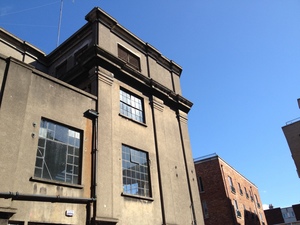
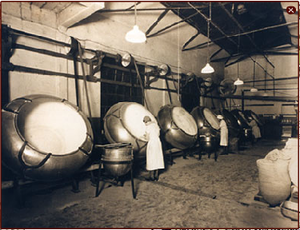
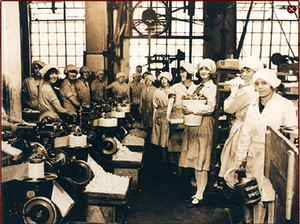
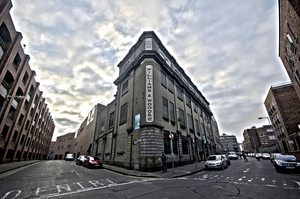 D
D
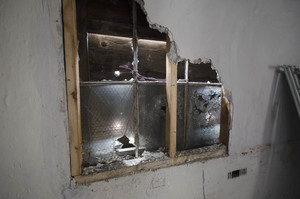
-
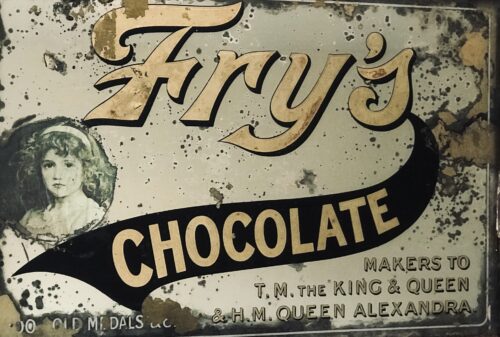
 Fantastic Frys Chocolate Advertising Mirror circa early 1900s. 40cm x 55cm Dublin S. Fry & Sons, Ltd. better known as Fry's, was a British chocolate company owned by Joseph Storrs Fry and his family. Beginning in Bristol in the 18th century, the business went through several changes of name and ownership, becoming J. S. Fry & Sons in 1822. In 1847, Fry's produced the first solid chocolate bar.[1][2] The company also created the first filled chocolate sweet, Cream Sticks, in 1853.[1] Fry is most famous for Fry's Chocolate Cream, the first mass-produced chocolate bar which was launched in 1866, and Fry's Turkish Delight, launched in 1914.[1] Fry, alongside Cadbury and Rowntree's, were the big three British confectionery manufacturers throughout much of the nineteenth and twentieth centuries.[3] The company became a division of Cadbury in the early twentieth century. The division's Somerdale Factory near Bristol was closed after the 2010 takeover of Cadbury's by Kraft Foods.
Fantastic Frys Chocolate Advertising Mirror circa early 1900s. 40cm x 55cm Dublin S. Fry & Sons, Ltd. better known as Fry's, was a British chocolate company owned by Joseph Storrs Fry and his family. Beginning in Bristol in the 18th century, the business went through several changes of name and ownership, becoming J. S. Fry & Sons in 1822. In 1847, Fry's produced the first solid chocolate bar.[1][2] The company also created the first filled chocolate sweet, Cream Sticks, in 1853.[1] Fry is most famous for Fry's Chocolate Cream, the first mass-produced chocolate bar which was launched in 1866, and Fry's Turkish Delight, launched in 1914.[1] Fry, alongside Cadbury and Rowntree's, were the big three British confectionery manufacturers throughout much of the nineteenth and twentieth centuries.[3] The company became a division of Cadbury in the early twentieth century. The division's Somerdale Factory near Bristol was closed after the 2010 takeover of Cadbury's by Kraft Foods.History[edit]
Joseph Fry, a Quaker, was born in 1728. He started making chocolate around 1759. In 1761 Joseph Fry and John Vaughan purchased a small shop from an apothecary, Walter Churchman, and with it the patent for a chocolate refining process.The company was then named Fry, Vaughan & Co.. In 1777 their chocolate works moved from Newgate Street to Union Street, Bristol. Joseph Fry died in 1787 and the company was renamed Anna Fry & Son. In 1795 Joseph Storrs Fryassumed control of the company. He patented a method of grinding cocoa beans using a Watt steam engine. As a result, factory techniques were introduced into the cocoa business. In 1803 Anna Fry died and Joseph Storrs Fry partnered with a Dr. Hunt. The business was renamed Fry & Hunt. In 1822 Hunt retired and Joseph Storrs Fry took on his sons Joseph, Francis and Richard as partners: the firm was renamed J. S. Fry & Sons. The company became the largest commercial producer of chocolate in the UK. In 1835 Joseph Storrs Fry died and his sons took full control. Tom Browne‘s advertisement postcard for Fry's chocolate, 1912In 1847, the Fry's chocolate factory, located in Union Street, Bristol, moulded a chocolate bar suitable for large-scale production.The firm began producing the Fry's Chocolate Cream bar in 1866.Over 220 products were introduced in the following decades, including production of the first chocolate Easter egg in UK in 1873 and the Fry's Turkish Delight (or Fry's Turkish bar) in 1914. In 1896 the firm became a registered private company. It was run by the Fry family, with Joseph Storrs Fry II, grandson of the first Joseph Storrs Fry, as the chairman. In 1881, an employee of Fry's H. J. Packer established his own chocolate business in Bristol. At its eventual home in Greenbank, Bristol, Packer's Chocolate continued to provide local competition for Fry's until 2006, under various owners and brands, from Bonds through to Famous Names and Elizabeth Shaw. Near the start of World War I the company was one of the largest employers in Bristol. Joseph Storrs Fry II died in 1913. By 1919 the company merged with Cadbury's chocolate and the joint company named British Cocoa and Chocolate Company. Under Egbert Cadbury the Fry's division began the move to Somerdale, Keynsham in 1923. After 1981 the name Fry's was no longer in use at Somerdale, but the factory was still a major producer of Cadbury's products. On 3 October 2007, Cadbury announced plans to close the Somerdale plant, the historic home of the Fry's Factory, by 2010 with the loss of some 500 jobs. In an effort to maintain competitiveness in a global marketplace, production was to be moved to a new factory in Poland. Another motivational factor was the high value of the land. Labour MP for Wansdyke, Dan Norris, said, "News of the factory's closure is a hard and heavy blow, not just to the workforce, but to the Keynsham community as a whole". In February 2010, following the takeover of Cadbury plc by Kraft Foods, the closure was controversially confirmed to take place in 2011; Kraft had specifically agreed during the takeover battle to keep the site open. There was widespread outrage in the press and later a House of Commons Select Committee investigation into the affair.Advertisement with the distinctive "five boys" design expressing "Desperation, Pacification, Expectation, Acclamation and Realization "It's Fry's". The reference to Queen Alexandra indicates a date before her death in 1925. Displayed in the Kirkcaldy Museum and Art Gallery
Tom Browne‘s advertisement postcard for Fry's chocolate, 1912In 1847, the Fry's chocolate factory, located in Union Street, Bristol, moulded a chocolate bar suitable for large-scale production.The firm began producing the Fry's Chocolate Cream bar in 1866.Over 220 products were introduced in the following decades, including production of the first chocolate Easter egg in UK in 1873 and the Fry's Turkish Delight (or Fry's Turkish bar) in 1914. In 1896 the firm became a registered private company. It was run by the Fry family, with Joseph Storrs Fry II, grandson of the first Joseph Storrs Fry, as the chairman. In 1881, an employee of Fry's H. J. Packer established his own chocolate business in Bristol. At its eventual home in Greenbank, Bristol, Packer's Chocolate continued to provide local competition for Fry's until 2006, under various owners and brands, from Bonds through to Famous Names and Elizabeth Shaw. Near the start of World War I the company was one of the largest employers in Bristol. Joseph Storrs Fry II died in 1913. By 1919 the company merged with Cadbury's chocolate and the joint company named British Cocoa and Chocolate Company. Under Egbert Cadbury the Fry's division began the move to Somerdale, Keynsham in 1923. After 1981 the name Fry's was no longer in use at Somerdale, but the factory was still a major producer of Cadbury's products. On 3 October 2007, Cadbury announced plans to close the Somerdale plant, the historic home of the Fry's Factory, by 2010 with the loss of some 500 jobs. In an effort to maintain competitiveness in a global marketplace, production was to be moved to a new factory in Poland. Another motivational factor was the high value of the land. Labour MP for Wansdyke, Dan Norris, said, "News of the factory's closure is a hard and heavy blow, not just to the workforce, but to the Keynsham community as a whole". In February 2010, following the takeover of Cadbury plc by Kraft Foods, the closure was controversially confirmed to take place in 2011; Kraft had specifically agreed during the takeover battle to keep the site open. There was widespread outrage in the press and later a House of Commons Select Committee investigation into the affair.Advertisement with the distinctive "five boys" design expressing "Desperation, Pacification, Expectation, Acclamation and Realization "It's Fry's". The reference to Queen Alexandra indicates a date before her death in 1925. Displayed in the Kirkcaldy Museum and Art GalleryArchives
Records relating to both the business and the family are held at Bristol Archives (Ref. 38538). Some records concerning the role of J. S. Fry & Sons within Cadbury are held with the Mondelez International repository at Cadbury's UK headquarters in Bournville.Popular culture
On the BBC television program Being Human, an old Fry's Cocoa billboard hangs prominently on the side of the B&B where the main characters reside in Series 3–5. The billboard is a nod to the show's original Bristol location. In April 2020 an original enamel advertising sign with the distinctive "five boys" trademark design was featured on BBC's Antiques Roadshow and was valued at £1,000-£1,500. The boy featured in the design, Lindsay Poulton, had been photographed in 1886 by his father who, for the first image, soaked a cloth in ammonia and wrapped it round the boy's neck to make him cry. Poulton, in his eighties, related this story to Fry's employees when he was given a tour of the Bristol factory.-
Somerdale Factory soon after opening
See also[edit]
-
-

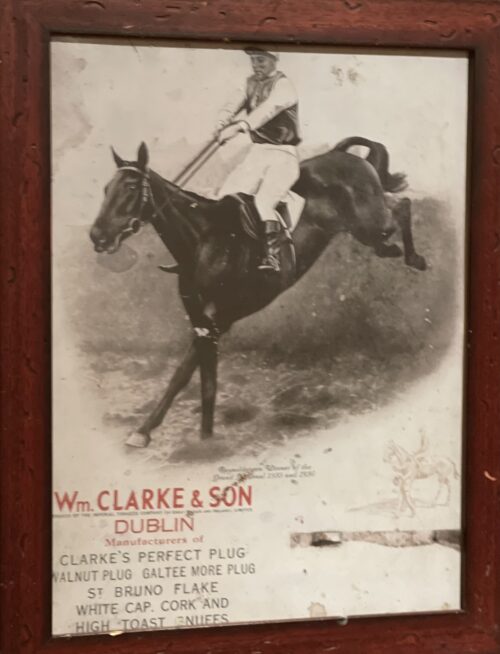 47cm x 35cm During its 180 year history, the Grand National has seen only five horses win consecutive runnings, with this year's victor Tiger Roll joining that exclusive list of dual winners. Until the legendary Red Rum, the last horse to win on his immediate return to Aintree was Reynoldstown, who won the 1935 Grand National in the hands of Mr Frank Furlong - a subaltern in the 9th Lancers - and again the following year ridden by Furlong's great friend and fellow Army officer Mr Fulke Walwyn, later to become a multi-time champion National Hunt trainer. Although two totally different kinds of horses, the long, lean, black Reynoldstown and the diminutive Tiger Roll share a parallel in that both had Flat-bred sires. Reynoldstown was by the good-class My Prince who won among other races the Union Jack Stakes at Aintree but went on to become more famous as an outstanding sire of National Hunt horses including Grand National winners Gregalach (1929) and Royal Mail (1937), while Tiger Roll's father Authorized won the 2007 Epsom Derby under Frankie Dettori. Reynoldstown's dam Fromage was the product of a modest mating to the nearest sire who was within walking distance.
47cm x 35cm During its 180 year history, the Grand National has seen only five horses win consecutive runnings, with this year's victor Tiger Roll joining that exclusive list of dual winners. Until the legendary Red Rum, the last horse to win on his immediate return to Aintree was Reynoldstown, who won the 1935 Grand National in the hands of Mr Frank Furlong - a subaltern in the 9th Lancers - and again the following year ridden by Furlong's great friend and fellow Army officer Mr Fulke Walwyn, later to become a multi-time champion National Hunt trainer. Although two totally different kinds of horses, the long, lean, black Reynoldstown and the diminutive Tiger Roll share a parallel in that both had Flat-bred sires. Reynoldstown was by the good-class My Prince who won among other races the Union Jack Stakes at Aintree but went on to become more famous as an outstanding sire of National Hunt horses including Grand National winners Gregalach (1929) and Royal Mail (1937), while Tiger Roll's father Authorized won the 2007 Epsom Derby under Frankie Dettori. Reynoldstown's dam Fromage was the product of a modest mating to the nearest sire who was within walking distance.Reynoldstown, named after the local townland of the small village of Naul near Dublin, was foaled there in 1927 by cattle farmer Dick Ball - who also bred the great Ballymoss. Dick's father had raised Fromage by hand himself after her mother died foaling. As a five-year-old, Reynoldstown was bought for £1,500 by Major Noel Furlong for his son Frank to ride in steeplechases. A leading Irish point-to-point rider himself, Major Furlong had had his interest in the Grand National sparked one year when, still in the Army, he'd travelled to Liverpool to watch the big race. In the train carriage, he overheard people talking about the chances of their horse winning and, when he saw this come to pass later that day, declared "That's it! I'm going to win the National myself." Major Furlong trained just two or three horses of his own in Skeffington, Leicestershire. Reynoldstown proved to be very hot and excitable throughout his career and was never ridden by anyone - at home or in races - apart from Major Furlong, Frank or Fulke. Reynoldstown won four hurdle races and eight 'chases before his first Grand National success in 1935, which saw him score by three lengths and break Golden Miller's record for the race - his time of 9 minutes 20.20 seconds standing until Red Rum beat it in 1973. The newspaper headlines ran: "Grand National won by two Furlongs!" Reynoldstown suffered leg problems afterwards which forced a long lay-off. Major Furlong followed the old adage "time, tar and tarmac", coating his legs with tar and giving him lots of roadwork to get him sound again. The horse duly came back to win the 1936 Grand National by twelve lengths, this time in the hands of Walwyn, since Frank Furlong was unable to make the weight. There was drama at the final fence after the reins broke on challenger Davy Jones, leaving rider Anthony Mildmay (after whom the Mildmay Course at Aintree is named) powerless to prevent the horse running out into the crowds. Reynoldstown did not attempt the hat trick. He was retired immediately after his Grand National success, the Furlongs considering - not unlike the connections of Tiger Roll - that he had done enough to prove himself and owing them nothing. He spent his retirement with Major Furlong at Marston St Lawrence near Banbury, where he was put down at the age of 24 after contracting tetanus. He is buried there, alongside the 1972 Grand National winner Well To Do. Curiously, he was never turned out in the field but was exercised instead on a lungeing rein by his devoted lifelong groom McCarthy, who brushed him and took him for a pick of grass and a welcome roll every day. Sadly, for Major Furlong, the aftermath was not so happy. His son Frank, who had left the Army and set up training himself near Lambourn, enlisted in the Fleet Air Arm at the outbreak of World War II and, though flying successfully on many combat missions, was killed when the Spitfire prototype Spiteful he was testing developed a fault and crashed on Salisbury Plain in 1944. He left a widow and a baby daughter, Grizelda, who today, as an octogenarian, recalls with affection being brought up by her grandparents and sitting on Reynoldstown's back as a pony-mad youngster. She clearly remembers stories Major Furlong would tell, including that of the 1934 Grand National in which both Frank and Fulke rode. Both their horses came down at the 26th fence when going well and the two riders were left thumping the turf in frustration. Major Furlong confronted the disgruntled friends in the Weighing Room afterwards with the prophetic words: "Don't worry, I shall have a Grand National winner for both of you." Another tale he told her concerned Frank and Fulke, in a hurry to reach the traditional party at the Adelphi Hotel, joyfully overtaking the traffic jams outside Aintree after one of their National wins. A policeman pulled the singing and shouting pair over with the words "What do you think you're doing? Anyone would think you'd just won the Grand National!" Grizelda smiles when she recounts her grandfather telling her how Reynoldstown's horsebox was held up by a funeral on the way to the 1935 Grand National. Major Furlong considered it lucky to see a funeral so the following year waited around in the hope of another before they reached the course. None appeared - but they did manage to spot a black cat - which obviously had the same desired effect. Quote: Attempting to compare Reynoldstown and Tiger Roll, Grizelda says: "The Grand National today is a totally different race and the fences are so much smaller. You cannot compare the two, but Tiger Roll is obviously a wonderful horse and thoroughly deserved both his wins and the adulation he received. We always gathered round as a family to watch the National on TV and this year was no exception. I really did think Tiger Roll would win." William Clarke & Son was a tobacco company that was founded in 1830 at South Main Street, Cork, Ireland. In January 1924, following the formation of the Irish Free State, the United Kingdom trade of William Clarke & Son was transferred to Dublin and taken over by Ogden's.
William Clarke & Son, Dublin
William Clarke was founded in 1830 at South Main Street in Cork, however by 1870 the manufacturing side of the business had all been transferred to Hare Place, Scotland Road, Liverpool, with only depots remaining in Ireland. Following the formation of the Irish Free State in 1926, the Liverpool based operation was taken over by Ogden’s, while a new factory was set up at South Circular Road in Dublin to produce tobacco and snuff under the William Clarke & Son brand. In 1929 William Clarke was amalgamated with Wills’s Irish branch, which resulted in Wills’s Irish production being integrated into the new South Circular Road factory in Dublin, though senior management were based in Wills’s Bristol operations and the Irish entity ultimately reported back into Bristol.


